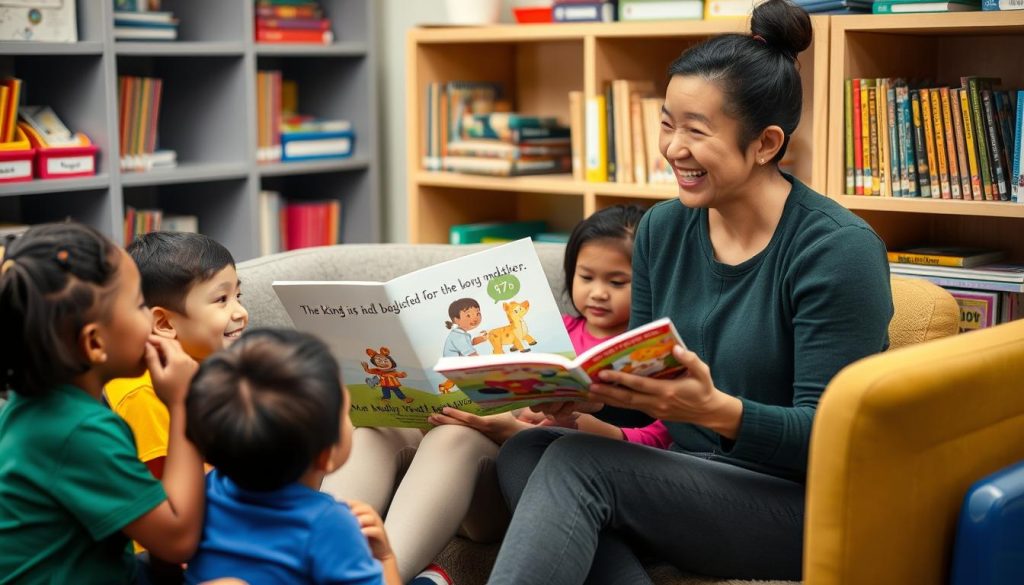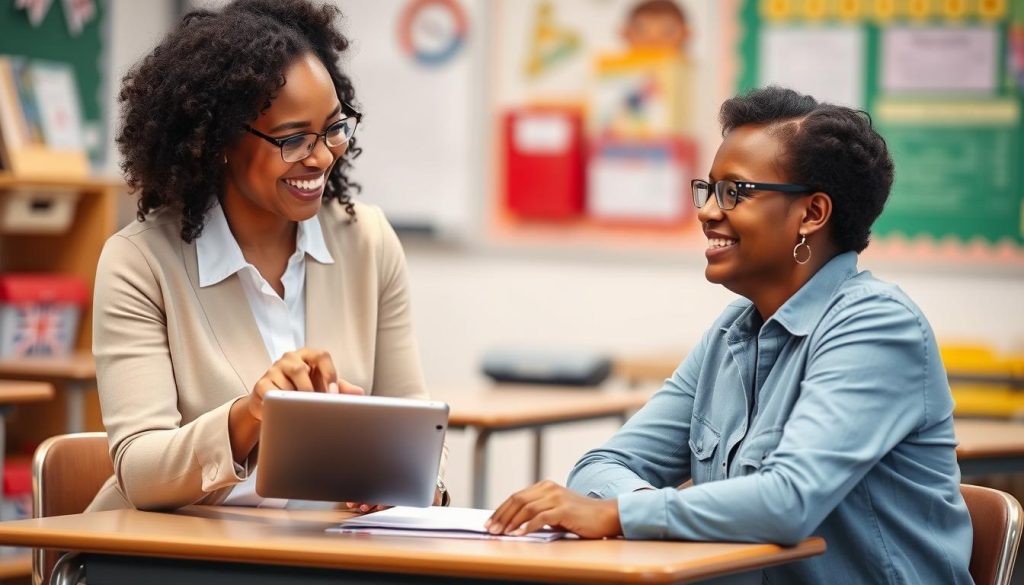Effective parent-teacher communication forms the foundation of successful educational partnerships
Tip #1: Start Early to Foster Relations
The first few weeks of school are crucial for establishing positive parent-teacher relationships. Don’t wait for problems to arise before reaching out. Proactive communication demonstrates your commitment to their child’s success and sets the tone for the entire year.
Begin by sending a welcome email or letter introducing yourself, your teaching philosophy, and your communication preferences. Include a brief questionnaire asking parents about their child’s strengths, challenges, and learning style. This simple teacher skill of initiating contact shows parents you value their input from day one.
“The relationship between parents and teachers is the foundation upon which we build educational success. When we establish this connection early, we create a partnership that benefits the student throughout their academic journey.”
Consider hosting an informal meet-and-greet before the official back-to-school night. This relaxed setting allows you to begin building rapport with families in a low-pressure environment. Remember that first impressions matter—your warmth, approachability, and organization during these initial interactions will shape parents’ perceptions of you throughout the year.
Research from the National PTA shows that early parent engagement leads to higher student achievement, better attendance, and improved behavior. These tips to foster relations early in the school year create a foundation for ongoing collaboration.
Tip #2: Communicate Consistently to Foster Relations
Consistent communication is a fundamental teacher skill that builds trust with parents. Establish a regular schedule for updates—whether weekly newsletters, monthly progress reports, or periodic emails—and stick to it. Parents appreciate knowing when and how they’ll receive information about their child’s education.
Regular digital communication helps maintain strong parent-teacher connections
Vary your communication methods to accommodate different parent preferences and schedules. Some effective channels include:
- Class websites or blogs with regular updates
- Digital platforms like ClassDojo, Seesaw, or Google Classroom
- Weekly or bi-weekly email newsletters
- Monthly printed newsletters for families with limited internet access
- Text message systems for quick reminders
When communicating, maintain a balance between whole-class updates and personalized messages. While class newsletters keep everyone informed about general activities, parents also value individual notes about their child’s specific progress or achievements.
Remember that consistency doesn’t mean overwhelming parents with information. Quality matters more than quantity. Focus on meaningful updates that give parents insight into their child’s learning experience and provide opportunities for them to support education at home.
Enhance Your Communication Skills
Looking for proven strategies to improve your parent communication? Our comprehensive course offers templates, scripts, and techniques that save you time while building stronger relationships.
Tip #3: Use Active Listening as Essential Teacher Skills
Active listening ranks among the most crucial teacher skills for building parent relationships. When parents feel truly heard, they’re more likely to become engaged partners in their child’s education. This approach to foster relations requires your full attention, empathy, and a genuine desire to understand parents’ perspectives.
During parent conversations, practice these active listening techniques:
Verbal Active Listening
- Ask open-ended questions that encourage detailed responses
- Paraphrase what you’ve heard to confirm understanding
- Acknowledge emotions (“I understand this is frustrating”)
- Avoid interrupting or formulating responses while parents are speaking
Non-Verbal Active Listening
- Maintain appropriate eye contact
- Nod to show engagement
- Face the speaker directly
- Put away distractions like phones or computers
When parents share concerns, resist the urge to immediately offer solutions or defend your position. Instead, take time to understand the root of their concerns. Sometimes parents simply need to feel heard before they’re ready to collaborate on solutions.
“The most valuable gift we can give parents is our undivided attention. When we truly listen, we transform a conversation into a partnership.”
Remember that cultural differences can influence communication styles. Some parents may be more direct, while others might be more reserved. Adapting your listening approach to accommodate these differences is another important teacher skill that demonstrates respect and builds trust.
By implementing these tips to foster relations through active listening, you create an environment where parents feel valued and understood—the perfect foundation for productive collaboration.
Tip #4: Share Positive News to Foster Relations
Too often, parent communication focuses exclusively on problems or concerns. One of the most effective tips to foster relations is to regularly share positive news about students. When parents hear about their child’s successes, strengths, and improvements, they develop a more positive attitude toward school and are more receptive when challenges do arise.
Consider implementing these strategies for sharing good news:
- Send “positive postcards” highlighting specific achievements
- Make “good news calls” that surprise parents with positive feedback
- Create a “celebration corner” in your newsletters featuring student successes
- Share photos (with appropriate permissions) of students engaged in learning
- Send quick emails noting improvements or kind behaviors
The key to effective positive communication is specificity. Rather than generic praise like “Jamal had a good day,” share specific observations: “Jamal showed remarkable persistence today when solving a challenging math problem. He tried three different approaches before finding a solution.”
Aim for a 3:1 ratio of positive to constructive feedback. This balance helps build a reservoir of goodwill that strengthens your relationship with parents. When parents associate your communication with good news, they’re more likely to remain engaged and supportive partners.
Developing this teacher skill of consistent positive communication takes practice but yields significant benefits for your classroom community. As you implement these tips to foster relations through positive reinforcement, you’ll notice parents becoming more responsive and collaborative.
Tip #5: Establish Clear Boundaries While Building Relations
Healthy relationships require clear boundaries. As you implement tips to foster relations with parents, it’s equally important to establish professional parameters. Well-defined boundaries protect your time, maintain professionalism, and actually strengthen parent-teacher partnerships by setting realistic expectations.
Start the year by clearly communicating:
- Your preferred communication methods and platforms
- Appropriate times to contact you (and when you’re unavailable)
- Expected response timeframes (e.g., within 24-48 hours on weekdays)
- Protocols for scheduling meetings or conferences
- Guidelines for classroom visits or volunteering
Setting these boundaries isn’t about limiting access—it’s about creating sustainable communication practices. When parents understand your parameters, they’re less likely to feel frustrated by unmet expectations, and you’re less likely to experience burnout.
Professional Boundary Example: “I check email between 3:30-5:00 PM on school days and will respond within 24 hours. For urgent matters, please contact the school office at (555) 123-4567.”
Maintaining boundaries requires consistent reinforcement. If parents regularly contact you outside established hours, gently remind them of your communication policy. Most parents will respect your boundaries when they understand they’re designed to help you be the best teacher for their child.
The ability to establish and maintain professional boundaries is an essential teacher skill that contributes to your effectiveness and wellbeing. By modeling healthy boundaries, you also teach students this important life skill.
Master Parent-Teacher Relationships
Looking for more comprehensive strategies to build positive parent partnerships? Explore our professional development resources designed specifically for K-12 educators.
Tip #6: Embrace Cultural Sensitivity as Key Teacher Skills
Today’s classrooms reflect increasingly diverse communities. Effective tips to foster relations with parents must include cultural sensitivity and awareness. Understanding and respecting cultural differences is a vital teacher skill that builds trust with families from all backgrounds.

Building bridges across cultures strengthens the entire school community
Cultural sensitivity begins with self-awareness. Reflect on your own cultural background and how it shapes your expectations and communication style. Then, take proactive steps to learn about the cultures represented in your classroom:
- Research cultural norms regarding education, authority, and communication
- Invite parents to share aspects of their culture with the class
- Provide translated materials for non-English speaking families
- Consider cultural holidays when scheduling events
- Be mindful of cultural differences in non-verbal communication
Remember that cultural sensitivity isn’t about stereotyping. Each family is unique, even within a cultural group. The goal is to create an inclusive environment where all parents feel welcomed and valued.
A study from the National Education Association found that teachers who demonstrate cultural competence have significantly higher parent engagement rates. By developing this teacher skill, you create a more equitable and supportive learning community.
As you implement these tips to foster relations across cultural boundaries, you’ll build a richer classroom community that benefits from diverse perspectives and experiences.
Tip #7: Leverage Technology to Foster Relations Effectively
In today’s digital world, technology offers powerful tools to enhance parent-teacher communication. Strategic use of digital platforms is now an essential teacher skill that can save time while creating more meaningful connections with families.
When selecting technology tools to foster relations with parents, consider these options:
Communication Platforms
- ClassDojo for messaging and behavior updates
- Remind for quick text announcements
- Seesaw for sharing student work samples
- Google Classroom for assignments and resources
Virtual Meeting Tools
- Zoom or Google Meet for video conferences
- Calendly for easy scheduling
- Loom for recorded video messages
- Microsoft Teams for collaborative discussions
While technology offers many advantages, it’s important to implement it thoughtfully. Consider these best practices:
- Choose 1-2 primary platforms rather than overwhelming parents with multiple tools
- Provide clear instructions for accessing and using your chosen platforms
- Offer alternatives for families with limited technology access
- Maintain a professional tone in all digital communications
- Be mindful of privacy concerns when sharing photos or information

Teaching parents to use communication apps creates sustainable connections
Technology should enhance, not replace, personal connections. The most effective teachers combine digital tools with traditional communication methods like phone calls and face-to-face meetings. This balanced approach ensures all parents remain engaged, regardless of their technology comfort level.
By developing this teacher skill of leveraging appropriate technology, you can implement these tips to foster relations more efficiently while meeting the diverse needs of your parent community.
Tip #8: Create Meaningful Involvement Opportunities to Foster Relations
Parents want to be involved in their child’s education, but traditional volunteer opportunities don’t work for everyone. One of the most effective tips to foster relations is creating diverse, meaningful ways for parents to participate based on their interests, skills, and availability.
Consider these varied involvement opportunities:
In-Class Options
- Reading with small groups
- Leading centers or stations
- Sharing cultural traditions
- Demonstrating career skills
At-Home Support
- Preparing materials
- Translating documents
- Creating classroom resources
- Supporting homework routines
Special Events
- Organizing celebrations
- Chaperoning field trips
- Participating in career days
- Supporting family nights
When inviting parent involvement, be specific about what you need and how it benefits students. Parents are more likely to volunteer when they understand the purpose and impact of their contribution. For example, instead of a general request for “classroom help,” ask for “volunteers to listen to students read for 30 minutes on Tuesday mornings to build reading fluency.”

Meaningful parent involvement creates memorable learning experiences
Recognize that work schedules, childcare responsibilities, and other factors may limit some parents’ ability to volunteer during school hours. Developing the teacher skill of creating flexible involvement options demonstrates your commitment to inclusive partnerships.
Always acknowledge parent contributions, no matter how small. A simple thank-you note, public recognition in your newsletter, or student-made cards can make volunteers feel valued and encourage continued participation.
By implementing these tips to foster relations through meaningful involvement, you create a classroom community where parents feel welcomed as essential partners in education.
Strengthen Your Parent Partnership Skills
Want to learn more strategies for meaningful parent engagement? Our comprehensive course provides proven techniques for building collaborative relationships with families.
Tip #9: Navigate Difficult Conversations with Professional Teacher Skills
Even the strongest parent-teacher relationships face challenges. Knowing how to handle difficult conversations professionally is one of the most valuable tips to foster relations through challenging situations. This teacher skill helps transform potential conflicts into opportunities for deeper understanding and collaboration.
When preparing for difficult conversations, follow these guidelines:
Effective Approaches
- Schedule a private meeting in a neutral space
- Begin with positive observations about the student
- Present specific examples rather than generalizations
- Use “I” statements to express concerns
- Listen actively to parent perspectives
- Focus on solutions and next steps
Approaches to Avoid
- Discussing sensitive issues in public or via email
- Starting with a list of problems or complaints
- Making sweeping statements about behavior
- Using accusatory “you” statements
- Becoming defensive or dismissive
- Ending without an action plan
Remember that parents may bring their own school experiences, anxieties, or cultural perspectives to these conversations. Approaching difficult topics with empathy and understanding helps create a collaborative atmosphere even when discussing challenges.
“The way we handle difficult conversations often determines whether a parent becomes our strongest ally or our greatest challenge. With the right approach, even the most difficult discussion can strengthen our partnership.”
Document your conversations and agreed-upon action steps. This creates accountability and prevents misunderstandings. Follow up promptly to acknowledge progress and maintain open communication.
Developing this teacher skill of navigating difficult conversations with professionalism and empathy is essential for implementing effective tips to foster relations that withstand challenges and grow stronger over time.
Tip #10: Reflect and Adapt Your Approach to Foster Relations
The most successful teacher-parent relationships evolve over time. The final tip to foster relations effectively is developing the teacher skill of continuous reflection and adaptation. Regular assessment of your communication strategies allows you to refine your approach based on what works best for your specific classroom community.

Reflective practice helps teachers continuously improve their parent communication strategies
Consider implementing these reflection practices:
- Keep a communication journal noting successful strategies and challenges
- Solicit parent feedback through surveys or informal conversations
- Analyze which communication methods generate the most parent engagement
- Observe how colleagues build successful parent partnerships
- Participate in professional development focused on family engagement
Be willing to adjust your approach based on what you learn. Perhaps your weekly newsletter isn’t being read, but your quick text updates receive immediate responses. Or maybe some parents prefer phone calls to digital communication. Flexibility demonstrates your commitment to meeting families’ needs.
Remember that different families may require different approaches. The teacher skill of differentiated communication—adapting your style to match each family’s preferences and needs—creates more inclusive and effective partnerships.
By continuously reflecting on and refining your implementation of these tips to foster relations with parents, you create a dynamic, responsive approach to family engagement that grows stronger throughout the school year.
Building Lasting Partnerships: The Impact of Strong Parent Relations
Implementing these ten tips to foster relations with parents requires dedication and practice, but the benefits for students, families, and teachers are immeasurable. When parents and teachers form strong partnerships, students experience greater academic success, improved behavior, and increased motivation.
Remember that developing these teacher skills is an ongoing journey. Start by focusing on one or two strategies that resonate most with your teaching style and gradually incorporate others. Even small changes in your approach to parent communication can yield significant improvements in your classroom community.
“The strongest educational communities are built on a foundation of mutual respect, open communication, and shared commitment to student success. When teachers and parents truly partner, children thrive.”
As you implement these tips to foster relations with parents, you’ll discover that strong family partnerships not only enhance student outcomes but also bring greater joy and fulfillment to your teaching experience. The investment you make in building these connections creates a supportive community that benefits everyone involved.
Continue Your Professional Growth
Ready to take your parent communication skills to the next level? Explore our comprehensive resources designed specifically for K-12 educators.




